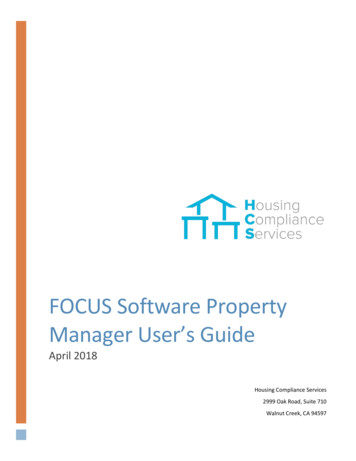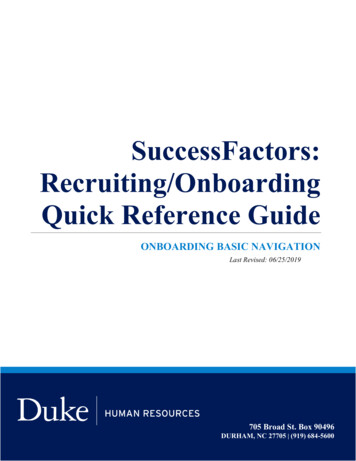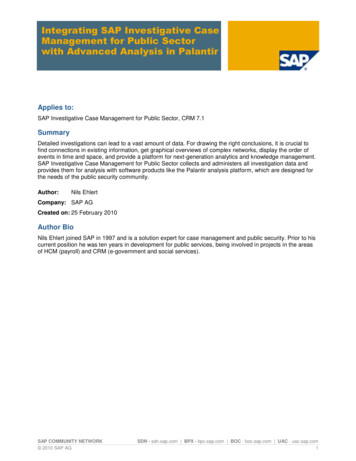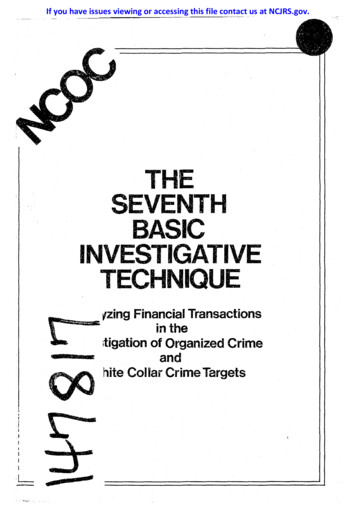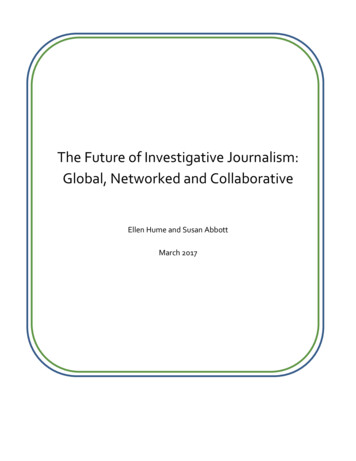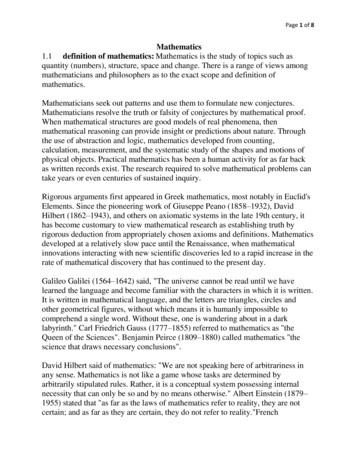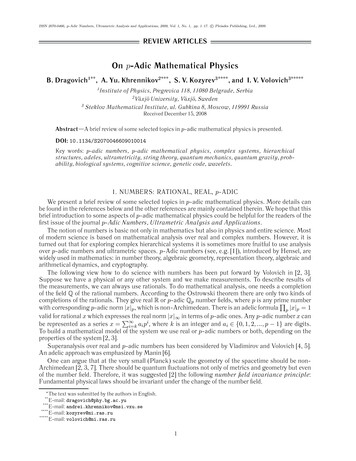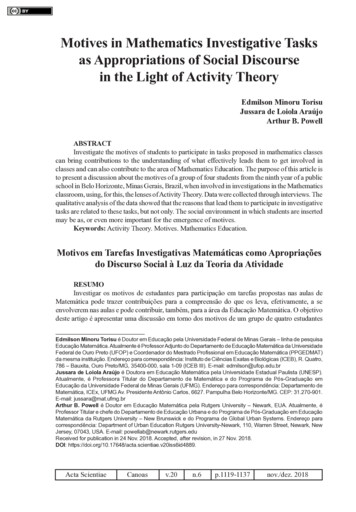
Transcription
Motives in Mathematics Investigative Tasksas Appropriations of Social Discoursein the Light of Activity TheoryEdmilson Minoru TorisuJussara de Loiola AraújoArthur B. PowellABSTRACTInvestigate the motives of students to participate in tasks proposed in mathematics classescan bring contributions to the understanding of what effectively leads them to get involved inclasses and can also contribute to the area of Mathematics Education. The purpose of this article isto present a discussion about the motives of a group of four students from the ninth year of a publicschool in Belo Horizonte, Minas Gerais, Brazil, when involved in investigations in the Mathematicsclassroom, using, for this, the lenses of Activity Theory. Data were collected through interviews. Thequalitative analysis of the data showed that the reasons that lead them to participate in investigativetasks are related to these tasks, but not only. The social environment in which students are insertedmay be as, or even more important for the emergence of motives.Keywords: Activity Theory. Motives. Mathematics Education.Motivos em Tarefas Investigativas Matemáticas como Apropriaçõesdo Discurso Social à Luz da Teoria da AtividadeRESUMOInvestigar os motivos de estudantes para participação em tarefas propostas nas aulas deMatemática pode trazer contribuições para a compreensão do que os leva, efetivamente, a seenvolverem nas aulas e pode contribuir, também, para a área da Educação Matemática. O objetivodeste artigo é apresentar uma discussão em torno dos motivos de um grupo de quatro estudantesEdmilson Minoru Torisu é Doutor em Educação pela Universidade Federal de Minas Gerais – linha de pesquisaEducação Matemática. Atualmente é Professor Adjunto do Departamento de Educação Matemática da UniversidadeFederal de Ouro Preto (UFOP) e Coordenador do Mestrado Profissional em Educação Matemática (PPGEDMAT)da mesma instituição. Endereço para correspondência: Instituto de Ciências Exatas e Biológicas (ICEB), R. Quatro,786 – Bauxita, Ouro Preto/MG, 35400-000, sala 1-09 (ICEB III). E-mail: edmilson@ufop.edu.brJussara de Loiola Araújo é Doutora em Educação Matemática pela Universidade Estadual Paulista (UNESP).Atualmente, é Professora Titular do Departamento de Matemática e do Programa de Pós-Graduação emEducação da Universidade Federal de Minas Gerais (UFMG). Endereço para correspondência: Departamento deMatemática, ICEx, UFMG Av. Presidente Antônio Carlos, 6627. Pampulha Belo Horizonte/MG. CEP: 31.270-901.E-mail: jussara@mat.ufmg.brArthur B. Powell é Doutor em Educação Matemática pela Rutgers University – Newark, EUA. Atualmente, éProfessor Titular e chefe do Departamento de Educação Urbana e do Programa de Pós-Graduação em EducaçãoMatemática da Rutgers University – New Brunswick e do Programa de Global Urban Systems. Endereço paracorrespondência: Department of Urban Education Rutgers University-Newark, 110, Warren Street, Newark, NewJersey, 07043, USA. E-mail: powellab@newark.rutgers.eduReceived for publication in 24 Nov. 2018. Accepted, after revision, in 27 Nov. 2018.DOI: 889.Acta ScientiaeCanoasv.20v.20, n.6p.1119-1137Acta Scientiae,n.6, nov./dez.2018nov./dez. 2018 1119
do nono de uma escola pública de Belo Horizonte, Minas Gerais, Brasil, quando envolvidos eminvestigações na sala de aula de Matemática, utilizando, para isso, as lentes da Teoria da Atividade.Os dados foram coletados por meio de entrevistas. A análise qualitativa dos dados mostrou queos motivos que os levam a participar de tarefas investigativas estão relacionados a estas tarefas,mas não somente. O entorno social no qual os estudantes estão inseridos pode ser tão, ou até maisimportante para o surgimento de motivos.Palavras-chave: Teoria da Atividade. Motivos. Educação Matemática.INTRODUCTIONIt is with increasing frequency that mathematics teachers are heard to report thelack of interests of students for classes in this subject (Powell, 1986; Shernoff & Schidt,2008). Intending to reverse this situation, some teachers seek alternative methods thatmay be more attractive to students or, in other words, motivates them to participate inmathematics classes (Middleton & Spanias, 1999; Singh, Granville, & Dika, 2002). Inthis search, one of the paths envisioned by teachers to motivate students is to engage themin mathematical investigations (Skovsmose, 2000; Ponte, Brocardo, & Oliveira, 2003).The idea behind teachers alternative methodologies such as mathematicalinvestigations is that such teaching approaches supply extra fuel to classes, leavingstudents more motivated (Wardekker et al, 2012). This has been promising and studied byseveral scholars (Maehr & Meyer, 1997; Stipek, 1993). However, unlike this conceptionof motivation, the present text will relate it to the concept of motive according to acultural-historical perspective in a context in which students are involved in mathematicalinvestigations in a classroom. The focus is on the motives by which students becomeengaged in investigative tasks in mathematics.Therefore, two key expressions that will guide this discussion are emphasized here:investigative tasks and motives.Mathematics classes based on investigative tasks consist of the proposal of opentasks for which several solutions are possible and in which students are directly involvedin experimentation leading to explorations, questions, conjectures, arguments, and soon. (Ponte, Brocardo, & Oliveira, 2003). A more detailed discussion of this trend inMathematics Education (ME) will be presented, below.The basic theoretical framework for our discussion is Cultural-Historical ActivityTheory (CHAT), the roots of which are found in the Russian school of psychologyfounded by Vygotsky in the 1920s and in which the concept of motive takes on greatimportance. According to Foot (2002, p.25), in this theory “motive always entails andindividual subjects personal relationship with the object of a collective activity, wherebymeaning is derived from the encounter between motive and object”. However, given theimportance of motives in this study, a more accurate discussion of this context will bediscussed below.Taking into account the diversity of activities in which students of basic educationare involved, the objective of this article is to present an analysis of the motives to1120Acta Scientiae, v.20, n.6, nov./dez. 2018
engage in investigative tasks in mathematics classes of four students from a Braziliansecondary school and, based on this analysis, to reexamine a theoretical understandingof motives.To achieve this objective, we have organized this article as follows. First, we addressthe fundamentals of CHAT with to how motives is understood in the CHAT framework,and present studies having different theoretical perspectives. Second, we discussmathematical investigations and present methodological aspects of our study. Finally,through our analysis of empirical data, we approach an understanding of the motives.CULTURAL-HISTORICAL ACTIVITY THEORYOne of the fundamental ideas of CHAT is that human development occurs as theindividual participates in cultural activities and appropriates historically constructedknowledge. However, this development is not unidirectional. At the same time that theindividual changes, that person changes the surrounding environment, as a two-waystreet, in a dialectical relationship.The notion of activity appeared with the studies of Vygotsky who, influenced by theidea of praxis as concrete and conscious historical activity, proposed a theory opposed tothe naturalism and passive receptivity of the empiricist tradition (Kozulin, 2002). Vygotskyargued that, between the person and the environment, there is a dialectical relationshipmediated by artifacts, materials or ideational. For him, mental development is the resultof the interactions of the person with nature and the sociocultural environment.Human activity, understood in this way, may be represented by Figure 1, thus:Figure 1. Structure of activity, according to Vygotsky.The subject directs actions toward the object of the activity, using artifacts asmediators. The representation in Figure 1 seeks to emphasize a way that the subject, actingon the object, transforms it and is also transformed by it. There are, however that therelationship between subject and object is always dialectically mediated by the artifactsin such, other elements that contribute to the constitution of human activity, primarilythat such activity is performed by a collective of subjects.Leontiev, a disciple of Vygotsky, was responsible for placing the collective characterof human activity in relief, in such a way “the individual could no longer be understoodActa Scientiae, v.20, n.6, nov./dez. 20181121
without his or her cultural means and the society could no longer be understood withoutthe agency of indiviudals who use and produce artifacts” (Engestrӧm, 2001, p.134). ForLeontiev (1978), an activity arises from a need that becomes a motive that guides theindividual toward an object that satisfies the need. However, it was Engestrӧm (2001),influenced by the ideas of Vygotsky and Leontiev, who created a representation ofcollective human activity using a triangle, as in Figure 2:Figure 2. Model of the activity system (Engestrӧm, 2001).This structure, which represents an activity system, describes and considers humanactivity as collective. According to Engestrӧm (1987), p.78).In the model, the subject refers to the individual or sub-group whose agency ischosen as the point of view in the analysis. The object refers to the ‘raw material’or ‘problem space’ at which the activity is directed and which is molded andtransformed into outcomes with the help of physical and symbolic, external andinternal mediating instruments, including both tools and signs. The communitycomprises multiple individuals and/or sub-groups who share the same general objectand who construct themselves as distinct from other communities. The division oflabor refers to both the horizontal division of tasks between the members of thecommunity and to the vertical division of power and status. Finally the rules refer tothe explicit and implicit regulations, norms and conventions that constrain actionsand interactions within the activity system (Engestrӧm, 1987, 78)In Engeström’s model, individuals’ agency expressed through their activity is thepoint of view of analysis. Their activity is guided by motives, and they are the focus ofthis article. Motive is one of the important theoretical constructs of CHAT, from whichhuman activity can be understood.MOTIVE IN CHATThe different approaches in the study of motives have resulted in fruitful discussionsabout this construct. Particularly, in the cultural-historical approach, scholars present varied1122Acta Scientiae, v.20, n.6, nov./dez. 2018
analytical perspectives (Hedegaard, 2012; Fleer, 2012; Torisu, 2014) often connectingthe motive to other psychological constructs.In his book, Activity, Consciousness and Personality, Leontiev (1978) argues thatan activity appears from a need, it becomes a motive, that guides the individual towardthe object of satisfaction of that need and that the motive coincides with the object ofthe activity. He writes:The fact is that in the subject s needy condition itself the object that is capable ofsatisfying the need is not sharply delineated. Up to the time of its first satisfactionthe need does not know its object; it must still be disclosed. Only as a result ofsuch disclosure does need acquire its objectivity and the perceived (represented,imagined) object, is arousing and directing activity of function; that is, it becomesa motive (Leontiev, 1978, p.161)However, there are those who disagree with the idea that motive is the object of theactivity (Bozhovich, 1968; Kaptelinin, 2005) or that the activity possesses a unique motive(Kaptelinin, 2005; Araújo, Santos, & Silva, 2010; Torisu, 2013). Kaptelinin (2005) arguesfor the possibility of activities being guided by more than one motive polymotivationalactivities and that they do not necessarily coincide with their objects.This and other forms of understanding motives in the cultural-historical approachreveal a wealth of research possibilities. Researchers throughout the world have dedicatedefforts to understanding motives in social practices in which individuals develop, suchas family, school, etc.Hedegaard (2012), for example, showed that in daily activities that are part ofa family routine (homework, dinner, etc.), children’s motive for learning is related toinstitutional and family values. Medina and Martinez (2012) showed how interactionamong peers during play contributes to the emergence of motives in children and howthe form of organization of this space of play varies from place to place, reflecting thevalues and norms of the world of the adults in each place. Fleer (2012) sought to learnhow children from Hong Kong who live in Australia develop motives for learning withinfamily practices. She found that “encouragement plays an important role in bridging thegap between parental demands and the child s wishes, which assists the child to appropriatefamily values, thus facilitating the development of a learning motive and learning itself”(Fleer, 2012, p.107). Winther-Lindqvist, (2012), performed a related study in which theauthor associated the Cultural-Historical Theory with the theory of social representations,discussed by Moscovici and the development of social identities, discussed by Duveen,to better understand the development of social identities of children and their motivesduring the transition from early childhood education to elementary school education.In all these studies, motive was understood as something that emerges from the socialrelations, that is, even though the existence of individual motives is acknowledged, theyemerge as the result of experiences of the subject in social groups.Acta Scientiae, v.20, n.6, nov./dez. 20181123
The present study s concerns motives in social practices within schools, particularlyin teaching-learning practices identified as mathematical investigation.MATHEMATICAL INVESTIGATIONSThe word “investigate” may assume various meanings, including to research,inquire, to discover something, to check and to examine a set of facts. In mathematics,many researchers and teachers support the use of mathematical investigations in classroom,and their arguments are varied. However, what really is a mathematical investigation?We can use as example two simple tasks and contrasted them gain an understandingof investigation in the mathematics classroom. Task 1: What is the sum of 8 and 7? Task2 is: How many different sums can be constructed whose result is 15? The first task istraditional and has a unique result, while the second has numerous solutions such as 8 7,-6 21, 21/3 40/5 and so on. The point is that leads to a mathematical investigation.In general, mathematics investigation permits tasks for which there is not one, uniquesolution. Thus, different paths may lead to different solutions and all possibly correct.During the investigations students experiment, explore and question which allows themgreater freedom to participate actively in their learning.Yet, when the students choose to participate in an investigation in mathematicsclassroom, what are their motives?Using the ideas discussed so far, our intention is to present a study about the motivesof four students when they were involved in investigative tasks in their mathematics class.The results may elicit discussions about what makes the student participate in school tasksand, as a consequence, provoke mathematics teacher to reflect about on the practice thuscontributing to the area of mathematics education.METHODOLOGYChaiklin (2012) discusses appropriate methods for investigating motives. Accordingto this author, everything depends on how the researcher understands what motive is. Forthe present authors, motives have a cultural-historical character and, in this sense, includethe entire web of relationships that compose the life of the individual. Thus, motives ofthe students, the participants of this study, were not seen only at the moment they wereinvolved in the activity, but also as something influenced by other moments of their lives.To access these moments, interviews were fundamental.However, these are not simple interviews in which the participants listed motivesfor their participation in the proposed mathematical investigative tasks. In interviews, thestudents were encouraged to talk about their families, about their relationships with schooland with mathematics, about their relationships with friends, in short, about their social world.The analyses of the responses to the questions about the themes cited permitted the authors1124Acta Scientiae, v.20, n.6, nov./dez. 2018
to establish connections between the students’ motives for participation in the mathematicaltasks and their social world. The responses brought with them marks about the lives of theparticipants which greatly influenced them in school and which, at times, became motivesfor participation in school. This corroborates Freitas’ (2002, p.29) ideas that, dealing withinterviews in research into the cultural historical perspective affirms that “the interview is theself-expressed subject, but the voice carries the sound of other voices, reflecting the realityof the group, gender, ethnicity, class, historical and social moment”. It also corroboratesChaiklin’s (2012) ideas that, in studies that understand motives as something inserted intoa system of relationships, it is necessary to interpret the interviews statements of the inrelation to social demands so that we may have access to the motives.The participants and the context of this study are presented, below.CONTEXT AND PARTICIPANTSThe participants were four students1 from the ninth year of a public school in the cityof Belo Horizonte, Brazil. Their fictitious names are Paulo, Lauro, Leandro and Gabriel.They all have studied in this school since their first year and, for this reason, had alreadycreated strong friendships.The school is located on the campus of a large public university. Admission is bylottery. The school is seen by the community as a good school. One reason for this is that itaffords graduates of its elementary school admission to a highly regarded technical school,without the student having to be compete in a selection process. This attracts students tothe school and a main reasons that parents participate in lottery selection.Paulo, Lauro, Leandro and Gabriel have participated in this context and, asparticipants of this study, are presented in detail in the chart, below:StudentRelationship withmathematicsPaulo(15 yearsold)Lauro(14 yearsold)Relationship withthe schoolAbout the familyFree timeLiked mathematics alot and was consideredan excellent studentboth by the teachersand his colleagues.Had a good relationshipwith everyone, teachersand colleagues.Lived with his parentsand one brother. Thefamily supported himwell in his studies andspared no efforts forhim to have a goodeducation.Plays football andvideo games.Preferred Physics tomathematics, but alsoliked mathematics.Understood that schoolwas a place to learnuseful things for dayto-day life and thefuture.Lived with his motherin an area in the sameregion as the school.Spent weekendswith his father. Hesaid that the family’sfinancial situationwas comfortableTennis and footballlessons.Number of the substantiated opinion issued by the Research Ethics Committee of UFMG, which approved theresearch: 20309162.1Acta Scientiae, v.20, n.6, nov./dez. 20181125
StudentRelationship withmathematicsRelationship withthe schoolAbout the familyFree timePlays ball, sleepsand flies kites.Watches TVseries, talks withfriends from theneighborhoodand goes to themovies.Leandro(14 yearsold)Had problems withmathematics. Hisperformance wasterrible.Liked school, butfelt hounded by theteachers.Lived with hismother, stepfatherand four siblings ina peripheral area ofBelo Horizonte. Thefinancial situationwas delicate and, forthis reason, it was hisdecision to help hismother who struggledhard for him to have agood education.Gabriel(17 yearsold)Did not have a goodrelationship withmathematics and hisgrades were low.Stated that he did notlike school becausehe had been retainedtwice. Did not likeparticipating inclasses.The family seemedto support him inschool, but notstrongly. He lived ina peripheral area withhis parents, siblingsand grandparents.Figure 3. Presentation of research subjects.We obtained this and other information from two set of interviews, conductedat different times. And, why did we feel the need to have more detailed informationabout the lives of the students in the group? We begin with the assumption that motivesemerge within social practices and because, according to Lave and Wenger (2002), thesocial world is seamless, meaning. That different moments are intertwined in the lives ofpeople. These moments do not exist in a vacuum. Lompscher (1999) also contributes tothis discussion when he recalls that motives are set during the process of human, socialactivity. People participate in various activities throughout their lives and this generatesa variety of motivations that influence other activities.Next, we present one of the tasks proposed to the groups.DATA AND ANALYSESInvestigative Tasks as ActivityOne of the tasks that we proposed was about cellular phone plans that were offered bya hypothetical company. Although this company did not really exist, the artificial situationwas very close to what individuals’ experiences, when they need to decide among cellularphone plans. In this task, a telecommunications company offered three telephone plans,each included a landline, a cell phone and text messaging. The variations among the planswere, basically, in the fixed monthly rates, the per-minute price for each type of call andthe allowed number of minutes of talktime, access-time to the Internet and number theamount of text messages. The students had to use calculations to show, among the threeoptions offered by the company, the best cost-benefit for a hypothetical user.1126Acta Scientiae, v.20, n.6, nov./dez. 2018
The profile of this user was the point of departure for the investigation of the bestplan. To make the situation closer to something real, the students could not ignore thefact that there are several other expenses that make up part of a person’s monthly budget.We suggested, then, that the students consider that an ideal budget would take 14% ofthe net salary to pay the telephone fees and services. They were then asked to consider aconsumer who receives R 2.500, 00 of net salary and spends, on average, R 170.00 onfees. Although this information had been provided that which dealt with the expensesfor telephone service was simulated by the students. They chose how the user was touse the cell phone.From the profile created for the user, the students had to use tables of values providedon a page that showed the task and, performing calculations data in the table, find theplan that best suited the needs of the user and was the most economical. We consider thestudents work on the task as an activity, represented in Figure 3.Figure 4. Activity: Cellular phone plan.Looking for Motives for Participation in the ActivityFollowing their work on the task, the students were interviewed in the same session.The idea was to learn why they had accepted the invitation to participate in the proposedstudy. What had motivated each one?Researcher: When you got involved in this type of task in the class, was there onemain reason? If yes, what was it?Paulo: I think there was one main reason.Researcher: What is it? What do you think it is?Paulo: I think that we are thinking about the future, right? (pause) if we need to do .like that, there are calculations there, we . we’re going to need it in the future, right?Lauro: No, I think there is a reason why. Because, somehow, there were someactivities related to math, but also to every day life [.]”.Paulo: Cell phones.Acta Scientiae, v.20, n.6, nov./dez. 20181127
Lauro: yeah, cell phones (agreeing with Paulo), some things that you can relate toevery day that help you, like with the help of math and more stuff, I think that you candevelop, get that practice and bring it into the every day part of your life. The stuff withthe cell phones and all.Researcher: Then you think that math, not all of it, at some point can help you lateron, in your everyday life?Lauro: Exactly, in the future when we’re working.Researcher: And you, Gabriel?Gabriel: More because of the day-to-day. we might need it. then, we know howto do what’s best.Researcher: Leandro.Leandro: I was also one of those students that thought, like what am I usingthis for? And then there was the cell phone and I understood more or less why we weredoing this because, sometimes you have a plan of something you wanted but you couldget it cheaper, depending on how much then I saw that you can use it every day, likeeverybody said.These responses would suggest that, in all cases, there was a predominating motivethat was related to the utilitarian vision of mathematics for use in daily life and in thefuture. But, would the possibility of everyday use of the mathematical knowledge involvedin the task be the only motive for these students to become involved?To attempt to answer this question, it was necessary to know more about the livesof these students, both inside and outside of school. This is consistent with the underlyingtheory to this study, for which the motives have a cultural-historical character and arematerials in the web of relationships that compose our lives. Therefore, a second interviewwas held in which the participants were heard individually to respond to different aspectsof their lives.Lompscher (1999) claims that a learning activity may have some categories ofmotives, among them social and cognitive motives. Social motives are associated withthe relationships that the students establish in their environment such as, for example,relationships with colleagues and teachers, relationships with parents, etc. Cognitivemotives are associated with the history of the student in relation to particular content.Repeated good performances may generate self-confidence in the students that motivatethem to be dedicated. The opposite may also occur.Understanding the investigative activity of this study as a learning activity, andbased on Lompscher’s (1999) motive categories, categories were created for the responsesgiven to the interviews to which the motives were linked. The categories were as follows:utilitarian vision of mathematics; family; school; relationship with mathematics.In the category ‘utilitarian vision of mathematics’, the students explained a littlemore, sometimes with examples, of why they responded that their participation in the1128Acta Scientiae, v.20, n.6, nov./dez. 2018
investigative activity was linked to the utilitarian vision of mathematics. Below, someof their responses to this category:Leandro: Oh yeah, the telephone. For me to learn. This can happen even in myevery day life, I’m looking at it, my bills there, and I noticed that an account in the planthat I could . that I talk less but actually spent more on the Internet – I could spend a lotless than I am spending on another plan.Gabriel: Yeah . Just like that stuff, PLIM, the operator. I spend more because of it.There, [.] like, if one day in my life I need to look at a plan, something like that, whichis better for me, then I can use that.Lauro: In society you have to know, at least, a minimum of Mathematics and that foryou to interact with people and everything, you have to know a minimum of mathematics.What time to get a bus, you could say .Learning mathematics for use in every day situations seemed to mobilize the studentsfor the tasks. It was one motive, but we were interested in finding out if there were others,especially because the importance that the mathematical content has, as something thatcan help us in every day life, is something widely discussed in social discourse. However,this reflected the influence of only one of the branches of the social web in which thestudents found themselves.In the second category of responses, the attempt is to learn what the students’relationships with their families were like. From the analyses of the responses, it couldbe understood how this relationship contributed to the emergence of motives for theinvestigative activity. For the entire group, the family was highly important. How didthey perceive that?Paulo came from a well-structured family, very concerned with his academicpreparation. This was evident when Paulo mentioned things like:Paulo: They give me the best conditions for studying, [ ] my family gives me alot of support with my studies, and many times she (mother) doesn’t go out to have fun,in order to stay home with me because I need to study.Such comments seemed to generate a feeling of commitment in Paulo, with hisparents and with himself. There is evidence of this in such responses as:Paulo: The fact that they give me everything that I ask for motivates me to studyharder and harder to show them that I am making it worthwhile and I only have fun whenmy conscience is totally clear, that is, when I don’t have to study or do any work.In Lauro’s case, the family was also important and seemed to have a discoursethat seemed similar to Paulo’s family. Although separated, his parents maintained a veryfriendly relationship that allowed Lauro to live in a healthy environment and to sharehis experiences with both, father and mother. The school was chosen by the father whoconsidered it a good place for his son’s studies. By being selected for the school, Lauromade his father very happy. He said:Acta Scientia
Matemática da Rutgers University - New Brunswick e do Programa de Global Urban Systems. Endereço para correspondência: Department of Urban Education Rutgers University-Newark, 110, Warren Street, Newark, New Jersey, 07043, USA. E-mail: powellab@newark.rutgers.edu Received for publication in 24 Nov. 2018. Accepted, after revision, in 27 Nov .
